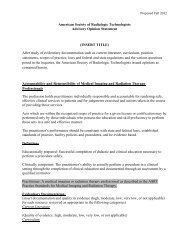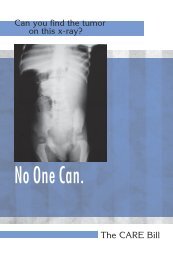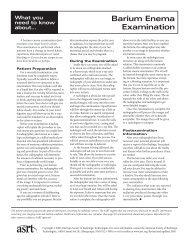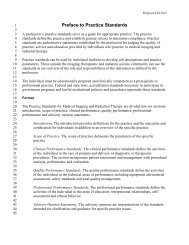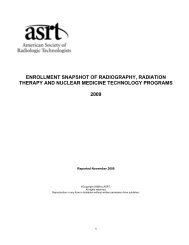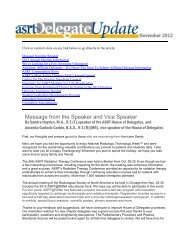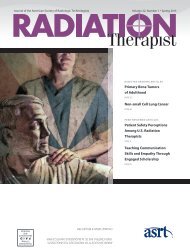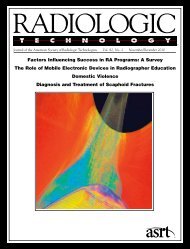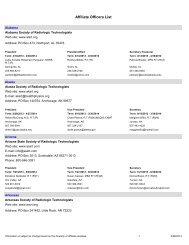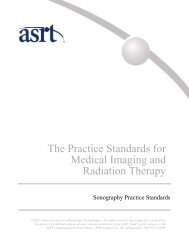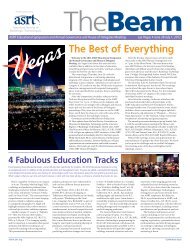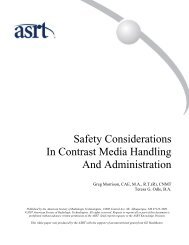Radiologist Assistant Curriculum - American Society of Radiologic ...
Radiologist Assistant Curriculum - American Society of Radiologic ...
Radiologist Assistant Curriculum - American Society of Radiologic ...
Create successful ePaper yourself
Turn your PDF publications into a flip-book with our unique Google optimized e-Paper software.
<strong>Radiologist</strong> Mentored Clinical Experience<br />
Description<br />
Mentored clinical experience is the cornerstone in the development <strong>of</strong> the radiologist assistant.<br />
RA students work closely with radiologist mentors to maximize the learning opportunities<br />
available in the clinical environment. It is recognized that no two diagnostic imaging centers will<br />
be exactly the same. The RA student and radiologist mentor collaborate to establish goals and<br />
expectations for this portion <strong>of</strong> the curriculum. A clear understanding <strong>of</strong> the degree <strong>of</strong> autonomy<br />
in the performance <strong>of</strong> diagnostic/ therapeutic procedures and the assistant’s contribution to the<br />
radiologist’s final diagnosis <strong>of</strong> these procedures is essential to the clinical experience.<br />
Prerequisite or Corequisite<br />
It is required that radiologist assistants possess or obtain certification in advanced cardiac life<br />
support (ACLS) in support <strong>of</strong> their role in the patient care setting.<br />
Objectives<br />
1. Demonstrate competence in performing diagnostic/therapeutic procedures under the<br />
supervision <strong>of</strong> a radiologist mentor.<br />
2. Provide initial observations and outcomes <strong>of</strong> examinations performed for review,<br />
interpretation and approval by the radiologist mentor.<br />
3. Assess, evaluate and formulate priorities in daily practice.<br />
4. Establish patient-centered clinically effective service delivery strategies.<br />
5. Implement and perform diagnostic/therapeutic procedures adhering to accepted<br />
departmental, institutional, governmental and pr<strong>of</strong>essional standards.<br />
6. Assess and evaluate the patient’s status and condition prior to, during and after diagnostic/<br />
therapeutic procedures.<br />
7. Apply the principles <strong>of</strong> radiation protection standards.<br />
8. Apply principles <strong>of</strong> quality improvement.<br />
9. Establish appropriate and effective written, oral and nonverbal communication with patient,<br />
family, health care providers and the public.<br />
10. Respect and recognize the clinical significance <strong>of</strong> the patient’s personal beliefs and values<br />
for adaptation to procedure protocols.<br />
11. Function within the radiologist assistant scope <strong>of</strong> practice and practice standards in<br />
accordance with state regulations and institutional policies.<br />
12. Assess and evaluate psychological and physical changes in the patient’s condition and<br />
formulate appropriate actions.<br />
13. Appraise cultural and age differences that influence patient compliance with procedural<br />
requirements.<br />
14. Interact with the patient and family in a manner that provides the desired psychosocial<br />
support.<br />
15. Document care in the patient’s medical record in accordance with institutional and legal<br />
guidelines.<br />
75<br />
© Copyright 2011 by the <strong>American</strong> <strong>Society</strong> <strong>of</strong> <strong>Radiologic</strong> Technologists. All rights reserved.



